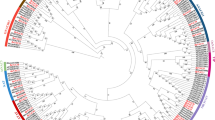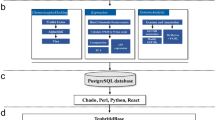Abstract
The olive fruit fly, Bactrocera oleae, is the major pest of the olive tree. Despite its importance, very little genetic and molecular knowledge is available. The present study is a first attempt to identify and characterize B. oleae expressed sequence tags (ESTs). One hundred and ninety-five randomly selected cDNA clones were isolated and the obtained sequences were annotated through BLASTX similarity searches. A set of 159 unique putative transcripts were functionally assigned using Gene Ontology terms in broad categories of biological process, molecular function and cellular component based on D. melanogaster matches. Moreover, the cytogenetic location of 35 ESTs was determined by in situ hybridization to B. oleae polytene chromosomes. The resulting low-resolution EST map more than doubles the available entry points to the insect’s genome and can assist syntenic comparisons with other distant species. The deduced codon usage of the isolated ESTs suggested a conserved pattern of B. oleae with its closest relatives. Additionally, the comparative analysis of B. oleae ESTs with the homologous D. melanogaster genes led to the development of 17 nuclear EPIC-PCR markers for the amplification of intron sequences of 11 Tephritidae species. Sequencing analysis of several cross-amplified intron sequences revealed a high degree of conservation among Bactrocera species and a varying transferability of the generated markers across the examined genera, suggesting that this method can provide a useful tool for the clarification of phylogenetic relationships among different species, particularly in cases of species complexes.







Similar content being viewed by others
References
Adams MD, Kelley JM, Gocayne JD, Dubnick M, Polymeropoulos MH, Xiao H, Merril CR, Wu A, Olde B, Moreno RF et al (1991) Complementary DNA sequencing: expressed sequence tags and human genome project. Science 252:1651–1656
Adams MD, Celniker SE, Holt RA, Evans CA, Gocayne JD, Amanatides PG, Scherer SE, Li PW, Hoskins RA, Galle RF et al (2000) The genome sequence of Drosophila melanogaster. Science 287:2185–2195
Altschul SF, Gish W, Miller W, Myers EW, Lipman DJ (1990) Basic local alignment search tool. J Mol Biol 215:403–410
Ashburner M, Ball CA, Blake JA, Botstein D, Butler H, Cherry JM, Davis AP, Dolinski K, Dwight SS, Eppig JT, Harris MA, Hill DP, Issel-Tarver L, Kasarskis A, Lewis S, Matese JC, Richardson JE, Ringwald M, Rubin GM, Sherlock G (2000) Gene ontology: tool for the unification of biology The Gene Ontology Consortium. Nat Genet 25:25–29
Augustinos AA, Stratikopoulos EE, Zacharopoulou A, Mathiopoulos KD (2002) Polymorphic microsatellite markers in the olive fly, Bactrocera oleae. Mol Ecol Notes 2:278–280
Augustinos AA, Mamuris Z, Stratikopoulos E, D’Amelio S, Zacharopoulou A, Mathiopoulos KD (2005) Microsatellite analysis of olive fly populations in the mediterranean indicates a westward expansion of the species. Genetica 125:231–241
Augustinos AA, Stratikopoulos EE, Drosopoulou E, Kakani EG, Mavragani-Tsipidou P, Zacharopoulou A, Mathiopoulos KD (2008) Isolation and characterization of microsatellite markers from the olive fly, Bactrocera oleae, and their cross-species amplification in the Tephritidae family. BMC Genomics 9:618
Benos P, Tavernarakis N, Brogna S, Thireos G, Savakis C (2000) Acquisition of a potential marker for insect transformation: isolation of a novel alcohol dehydrogenase gene from Bactrocera oleae by functional complementation in yeast. Mol Gen Genet 263:90–95
Berrebi P, Retif X, Fang F, Zhang CC (2006) Population structure and systematics of Opsariichthys bidens (Osteichthyes: Cyprinidae) in south–east China using a new nuclear marker: the introns (EPIC-PCR). Biol J Linn Soc Lond 87:155–166
Bolshakov VN, Topalis P, Blass C, Kokoza E, della Torre A, Kafatos FC, Louis C (2002) A comparative genomic analysis of two distant diptera, the fruit fly, Drosophila melanogaster, and the malaria mosquito, Anopheles gambiae. Genome Res 12:57–66
Bulmer M (1991) The selection–mutation–drift theory of synonymous codon usage. Genetics 129:897–907
Carbon S, Ireland A, Mungall CJ, Shu S, Marshall B, Lewis S, the AmiGO Hub and the Web Presence Working Group (2009) AmiGO: online access to ontology and annotation data. Bioinformatics 25:288–289
della Torre A, Favia G, Mariotti G, Coluzzi M, Mathiopoulos KD (1996) Physical map of the malaria vector Anopheles gambiae. Genetics 143:1307–1311
Deng Y, Dong Y, Thodima V, Clem RJ, Passarelli LA (2006) Analysis and functional annotation of expressed sequence tags from the fall armyworm Spodoptera frugiperda. BMC Genomics 7:264
Drosopoulou E, Scouras ZG (1995) The beta-tubulin gene family evolution in the Drosophila montium subgroup of the melanogaster species group. J Mol Evol 41(3):293–298
Drysdale R (2008) FlyBase Consortium 2008 FlyBase: a database for the Drosophila Research Community. Methods Mol Biol 420:45–59
Duret L (2002) Evolution of synonymous codon usage in metazoans. Curr Opin Genetics Dev 12:640–649
Economopoulos AP, Zervas GA (1982) Sterile insect technique and radiation in insect control. IAEA-SM-255/39 357–368
Economopoulos AP, Avtzis N, Zervas G, Tsitsipis J, Haniotakis G, Tsiropoulos G, Manoukas A (1977) Experiments on control of olive fly, Dacus oleae (Gmelin), by combined effect of insecticides and releases of gamma-ray sterilized insects. J Appl Entomol 83:201–215
Felsenstein J (1994) PHYLIP (Phylogeny Inference Package) version 3.6. Distributed by the Author. Department of Genome Sciences, University of Washington, Seattle
Fuhrmann M, Hausherr A, Ferbitz L, Schödl T, Heitzer M, Hegemann P (2004) Monitoring dynamic expression of nuclear genes in Chlamydomonas reinhardtii by using a synthetic luciferase reporter gene. Plant Mol Biol 55:869–881
Gariou-Papalexiou A, Gourzi P, Delprat A, Kritikou D, Rapti K, Chrysanthakopoulou B, Mintzas A, Zacharopoulou A (2002) Polytene chromosomes as tools in the genetic analysis of the Mediterranean fruit fly, Ceratitis capitata. Genetica 116:59–71
Goldman N, Yang Z (1994) A codon-based model of nucleotide substitution for protein-coding DNA sequences. Mol Biol Evol 11:725–736
Gomulski LM, Dimopoulos G, Xi Z, Soares MB, Bonaldo MF, Malacrida AR, Gasperi G (2008) Gene discovery in an invasive tephritid model pest species, the Mediterranean fruit fly, Ceratitis capitata. BMC Genomics 9:243
Goulielmos GN, Cosmidis N, Theodorakopoulou ME, Loukas M, Zouros E (2003) Tracing the history of an enzyme polymorphism: the case of alcohol dehydrogenase-2 (Adh-2) of the olive fruit fly Bactrocera oleae. Mol Biol Evol 20:293–306
Han HY (2000) Molecular phylogenetic study of the tribe Trypetini (Diptera: Tephritidae), using mitochondrial 16S ribosomal DNA sequences. Biochem Sys Ecol 120:501–513
Han HY, McPheron BA (1994) Phylogenetic study of selected Tephritid flies (Insecta: Diptera: Tephritidae) using partial sequences of the nuclear 18s ribosomal DNA. Biochem Sys Ecol 22:444–457
Han HY, McPheron BA (1997) Molecular phylogenetic study of tephritidae (insecta: diptera) using partial sequences of the mitochondrial 16S ribosomal DNA. Mol Phylogenet Evol 7:17–32
He M, Haymer DS (1997) Polymorphic intron sequences detected within and between populations of the Oriental fruit fly (Diptera:Tephritidae). Ann Entom Soc Am 90:825–831
He M, Haymer DS (1999) Genetic reletionships of populations and the origins of the new infestations of the Mediterranean fruit fly. Mol Ecol 8:1247–1257
Hirosawa M, Nagase T, Murahashi Y, Kikuno R, Ohara O (2001) Identification of novel transcribed sequences on human chromosome 22 by expressed sequence tag mapping. DNA Res 8:1–9
Holt RA, Subramanian GM, Halpern A, Sutton GG, Charlab R, Nusskern DR, Wincker P, Clark AG, Ribeiro JM et al (2002) The genome sequence of the malaria mosquito Anopheles gambiae. Science 298:129–149
Kakani EG, Ioannides IM, Margaritopoulos JT, Seraphides NA, Skouras PJ, Tsitsipis JA, Mathiopoulos KD (2008) A small deletion in the olive fly acetylcholinesterase gene associated with high levels of organophosphate resistance. Insect Biochem Mol Biol 38:781–787
Khila A, El Haidani A, Vincent A, Payre F, Souda SI (2003) The dual function of ovo/shavenbaby in germline and epidermis differentiation is conserved between Drosophila melanogaster and the olive fruit fly Bactrocera oleae. Insect Biochem Mol Biol 33:691–699
Koukidou M, Klinakis A, Reboulakis C, Zagoraiou L, Tavernarakis N, Livadaras I, Economopoulos A, Savakis C (2006) Germ line transformation of the olive fly Bactrocera oleae using a versatile transgenesis marker. Insect Mol Biol 15:95–103
Kumar S, Tamura K, Nei M (2004) MEGA 3: integrated software for Molecular Evolutionary Genetics Analysis sequence alignment. Brief Bioinform 5:150–163
Lagos D, Ruiz FM, Sánchez L, Komitopoulou K (2005) Isolation and characterization of the Bactrocera oleae genes orthologous to the sex determining Sex-lethal and doublesex genes of Drosophila melanogaster. Gene 348:111–121
Lagos D, Koukidou M, Savakis C, Komitopoulou K (2007) The transformer gene in Bactrocera oleae: the genetic switch that determines its sex fate. Insect Mol Biol 16:221–230
Mavragani-Tsipidou P (2002) Genetic and cytogenetic analysis of the olive fruit fly Bactrocera oleae (Diptera: Tephritidae). Genetica 116:45–57
Mavragani-Tsipidou P, Karamanlidou G, Zacharopoulou A, Koliais S, Kastritisis C (1992) Mitotic and polytene chromosome analysis in Dacus oleae (Diptera: Tephritidae). Genome 35(3):373–378
Mazomenos BE (1989) Dacus oleae. In: Robinson AS, Hooper G (eds) World crop pests. Vol.3B. Elsevier BV, Amsterdam, pp 169–177
Montiel Bueno A, Jones O (2002) Alternative methods for controlling the olive fly, Bactrocera oleae, involving semiochemicals. IOBC wprs Bull 25:1–11
Nam KD, Lee S, Zhou G, Clark T, Chen J, Rowley JD, Wang SM (2002) Oligo(dT) primer generates a high frequency of truncated cDNAs through internal poly(A) priming during reverse transcription. PNAS 99(9):6152–6156
Nardi F, Carapelli A, Dallai R, Roderick GK, Frati F (2005) Population structure and colonization history of the olive fly, Bactrocera oleae (Diptera, Tephritidae). Mol Ecol 14:2729–2738
Page RDM (1996) TreeView: an application to display phylogenetic trees on personal computers. Comput Appl Biosci 12:357–358
Palumbi SR, Baker CS (1994) Contrasting population structure from nuclear intron sequences and mtDNA of humpback whales. Mol Biol Evol 11:426–435
Papanicolaou A, Joron M, Mcmillan WO, Blaxter ML, Jiggins CD (2005) Genomic tools and cDNA derived markers for butterflies. Mol Ecol 14:2883–2897
Pringle EG, Baxter SW, Webster CL, Papanicolaou A, Chris Lee SF, Jiggins CD D (2007) Synteny and chromosome evolution in the Lepidoptera: evidence from mapping in Heliconius melpomene. Genetics 177:417–426
Rogozin IB, Sverdlov AV, Babenko VN, Koonin EV (2002) Analysis of evolution of exon–intron structure of eukaryotic genes. Brief Bioinform 6:18–134
Sambrook J, Fritch Ef, Maniatis T (1989) Molecular Cloning: a Laboratory Manual. ed. 2 Cold Spring Harbor Laboratory Press, Cold Spring Harbor, NY
Sharp PM, Averof M, Lloyd AT, Matassi G, Peden JF (1995) DNA sequence evolution: the sounds of silence. Philos Trans R Soc Lond Ser B 349:241–247
The Honeybee Genome Sequencing Consortium (2006) Insights into social insects from the genome of the honeybee Apis mellifera. Nature 443:931–949
Villablanca FX, Roderick GK, Palumbi SR (1998) Invasion genetics of the Mediterranean fruit fly: variation in multiple nuclear introns. Mol Ecol 7:547–560
Whitfield CW, Band MR, Bonaldo MF, Kumar CG, Liu L, Pardinas JR, Robertson HM, Soares MB, Robinson GE (2002) Annotated expressed sequence tags and cDNA microarrays for studies of brain and behavior in the honey bee. Genome Res 12:555–566
Zambetaki A, Kleanthous K, Mavragani-Tsipidou P (1995) Cytogenetic analysis of malpighian tubule and salivary gland polytene chromosomes of Bactrocera oleae (Dacus oleae) (Diptera: Tephritidae). Genome 38:1070–1081
Zambetaki A, Zacharopoulou A, Scouras ZG, Mavragani-Tsipidou P (1999) The genome of the olive fruit fly Bactrocera oleae: localization of molecular markers by in situ hybridization to salivary gland polytene chromosomes. Genome 42:740–751
Zhang D-X, Hewitt GM (2003) Nuclear DNA analyses in genetic studies of populations: practice, problems and prospects. Mol Ecol 12:563–584
Zygouridis NE, Augustinos AA, Zalom FG, Mathiopoulos KD (2009) Analysis of olive fly invasion in California based on microsatellite markers. Heredity 102:402–412
Acknowledgments
We thank Dr Komitopoulou at the Biology Department of Athens University (Greece) for the generous gift of the B. oleae cDNA library, which was used for the EST isolation. This research was partially supported by the Pythagoras II grant to KDM from the Greek Ministry of National Education and Religious Affairs and the Graduate Programs of the Biochemistry and Biotechnology Department of the University of Thessaly.
Author information
Authors and Affiliations
Corresponding author
Additional information
Communicated by S. Hohmann.
Electronic supplementary material
Below is the link to the electronic supplementary material.
Rights and permissions
About this article
Cite this article
Tsoumani, K.T., Augustinos, A.A., Kakani, E.G. et al. Isolation, annotation and applications of expressed sequence tags from the olive fly, Bactrocera oleae . Mol Genet Genomics 285, 33–45 (2011). https://doi.org/10.1007/s00438-010-0583-y
Received:
Accepted:
Published:
Issue Date:
DOI: https://doi.org/10.1007/s00438-010-0583-y




